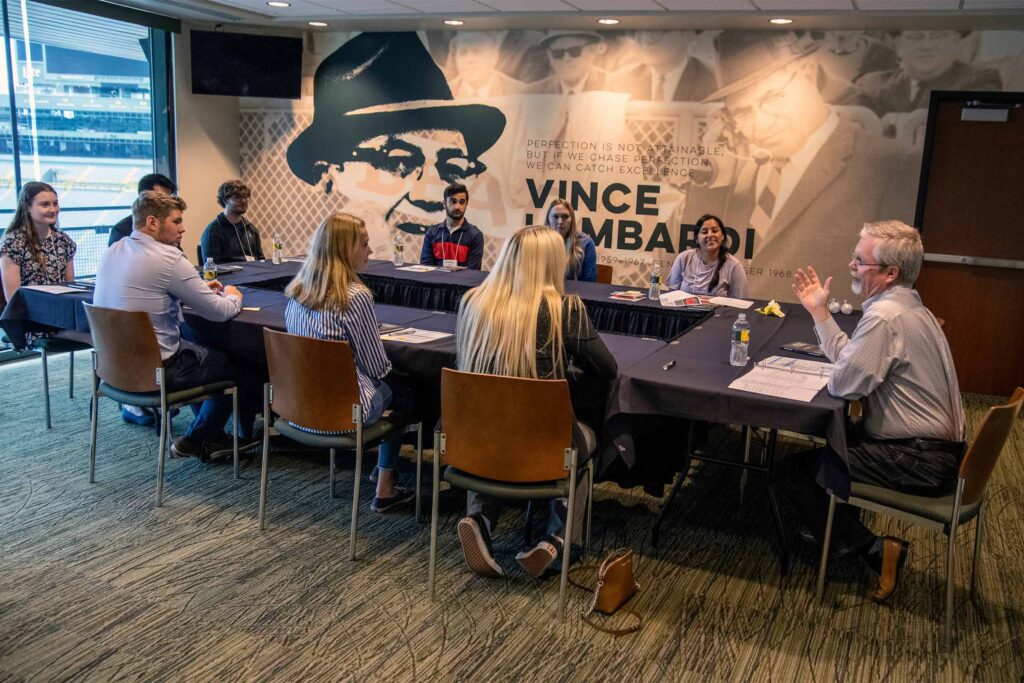
University of Wisconsin-Madison undergraduates participate in the popular Leadership at Lambeau badge. Students spend several days with the Green Bay Packers organization to act as ‘leadership consultants.’ The non-credit badge is one of several badges introduced in the undergraduate program. Courtesy photo
Dean Vallabh Sambamurthy has an ambitious vision for the undergraduate business program at University of Wisconsin-Madison.
Since taking over the deanship at the Wisconsin School of Business in 2019, he is overseeing an ambitious growth and reimagining project that began before his arrival. The school has enrolled 1,000 more students and hired 25 additional faculty in the last several years, and is now redesigning its bachelor of business administration degree to be more flexible, equitable and accessible. It will unveil a new curriculum in fall 2024.
The goal: to create a top tier program while setting up the undergraduate program to be the crown jewel of the Wisconsin School of Business.
“This is an area where I think we will be a business school to watch,” Sambamurthy told Poets&Quants at the Comprehensive Business School Dean’s Summit hosted by Emory’s Goizueta Business School earlier this spring. “We want to make this a top program not just in rankings, but in terms of student success.”
We recently sat back down with dean Sambamurthy to talk more deeply about his vision for the Wisconsin Badger BBA. Our conversation has been edited for length and clarity.
When you came to Wisconsin School of Business four years ago, what were some goals you set for the undergraduate program?
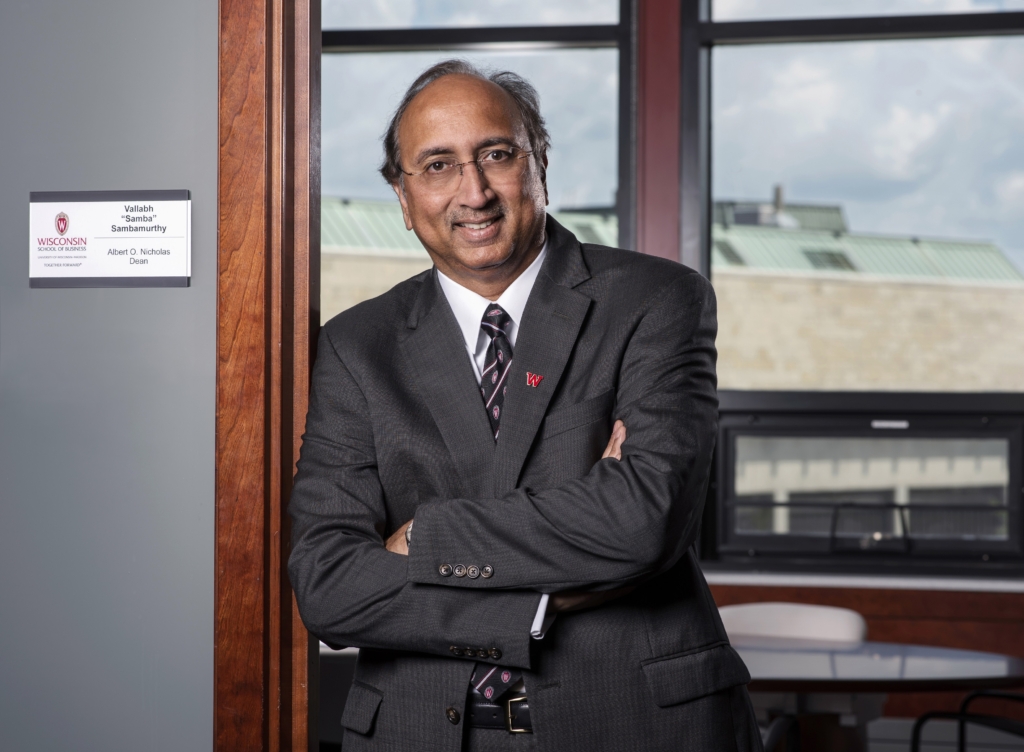
Dean Vallabh Sambamurthy
So when I came here in 2019, there were a few things already in motion for me to enhance and execute. Wisconsin’s School of Business embraced the direct admit model, so now we do 65% of our class as direct admit freshmen and 35% as sophomores. That’s a way to help make sure that we are recruiting the best and the brightest, but at the same time, kids need a chance to really learn what they want to do. So that’s a model that’s worked well for us.
The second thing that was already in motion was growth. The university and the business school, before I got here, had committed to adding 1,000 more students into the BBA which means that by 2025, we will be at 4,000 students. And that’s where we belong.
What I also saw is our historical strength in what I call functional competencies: We are No. 1 in real estate, we are No. 1 in Risk and Insurance. We have a strong presence in finance; Our alums are, if not the Titans, very successful on Wall Street and all of that. We are ranked No. 8 in marketing. My assessment was that we were very good in functional strengths and that it’s a great program. So, what’s next?
As part of our strategy, we drew a vision for the BBA on the premise that this will be the crown jewel, or the anchor of our program. It’s a program that has some of our best alumni. People come to Madison and fall in love with the place. So that’s when we began to craft a vision.
And what was the plan to make it happen?
When I came to Madison, I knew it was a great school. Candidly, I didn’t know what we were great for. So, we now have what we call our brand promise: Business Badgers are Trusted to Lead. You might have seen our campaign, and that’s beginning to resonate. We recently showcased 24 current students, and as we welcome new students, we are asking what’s your story?
So what do we mean by trusted to lead? At one level the story is Business Badgers connect the dots that others don’t see. Business Badgers bring passion to everything they do. At a time when the world needs business minded thinking, to be responsive to society, Business Badgers do that.
So what’s the value that we are building to embrace this? Focusing on our BBA program, our students will be trusted to lead as integrators – those who bring an integrative mindset – as multifunctional, global, as integrative business leaders.
Second is they are inclusive leaders at a time where we’re talking about diversity, representation, belongingness. Being an inclusive leader is a fundamental trait and a mindset.
And the third one is that Business Badgers are innovators. So that’s the guiding principle of our brand promise.
The next thing is we’re building around four principles: equity, access, flexibility, and choice. So what does that mean?
First, our student population should be diverse and representative. So when I came here, our students from underrepresented populations were less than 5%. Today we have 30% of our students come from underrepresented populations, additionally, 14% of our students are first generation students.”
Secondly, equity in everything we do, and opportunity for all. So we built a Multicultural Center as a place and a space for belongingness. That was an important statement that we made.
Similarly, we learned that many of our students will come from schools and backgrounds where they have not had the privilege of sitting at a dining table and having conversations about higher education and what’s possible. How do we make them feel that they belong? So we’ve invested in a model called Success Coaching — an ambassador and advocate who meets with you from day one, and grooms you into the mindset that it is desirable to go to them. It is OK to ask for help because everybody needs help. And what we’re finding is that that Success Coaching model in the first six or seven weeks instills the confidence and belief and then they’re off to the races.
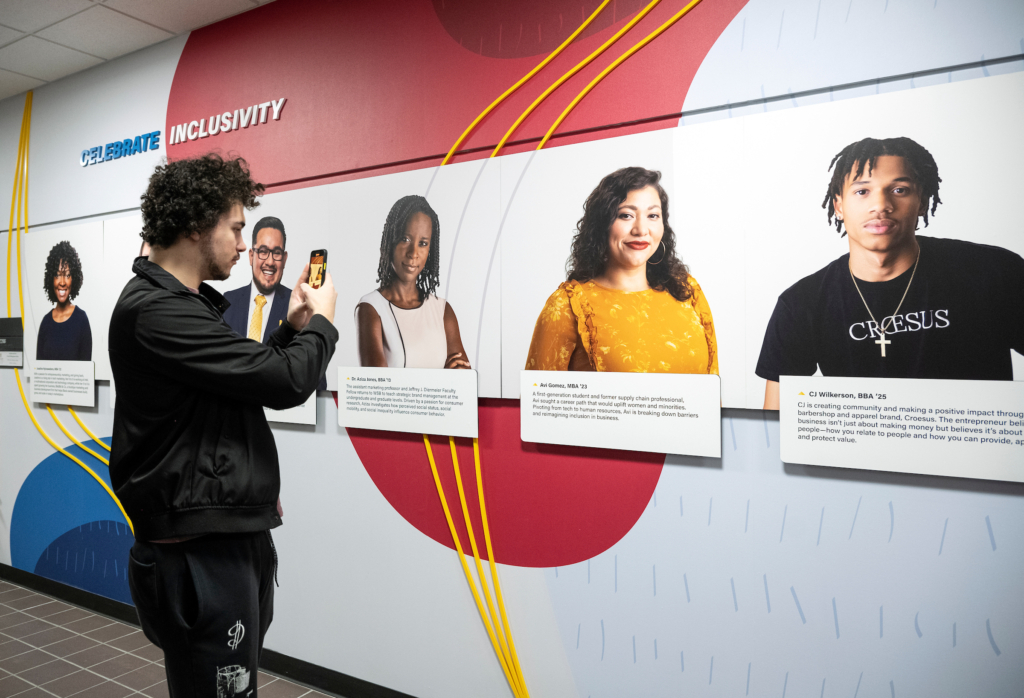
A student grabs a photo of the Multicultural Center’s new wallpaper and honorees display on this January. Photo by Paul L. Newby, II /UW-Madison Wisconsin School of Business)
Is that for every student?
Anybody who needs it. Surveys across business schools say there are 25% of the students who don’t use the resources, and they are the ones who need them. The Success Coaching is a unique element of the Wisconsin School of Business, beyond academic tutors and career coaches. So that’s equity and access.
As for flexibility, where there used to be traditional business careers, today we offer 44 different career paths. So you could come in and say, I want to be in finance. But journeys for investment banking, asset management, wealth management, and FinTech are very different. At some point, you will diverge in the courses, the clubs, the tracks, and case competitions for your path.
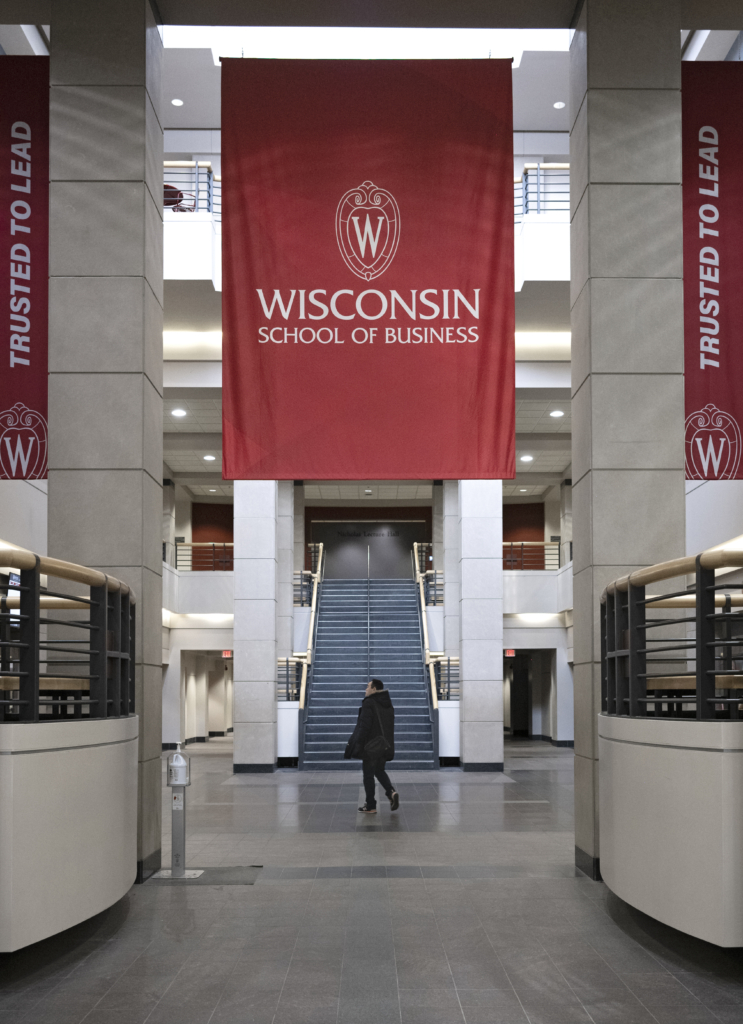
Wisconsin School of Business
As an example, for finance, there are five pathways, for marketing there are four. We discovered that we needed to add consulting because we didn’t have that. So now we’ve hired a consulting career pathway coach because consulting is not a course, it’s not a major, it’s a mindset and practice. These career pathway consultants sit at the sweet spot of employer relations, academic curriculum, co curricular experiences, and some career coaching.
Another unique element of our program is that beyond the career pathway consultant, we still have career coaches. Imagine a student coming to the Wisconsin School of Business and being enveloped by a triple coaching model. Success Coaches including academic tutors, there’s a career coach, and then there’s a pathway consultant.
When they come in, we tell them to explore. Don’t make up your mind. Don’t choose a major. By the end of their freshman year, we want them to start thinking about finance or marketing, etc. And by sophomore year, we want them to think about the pathway.
In the spirit of equity and access, we are now scaling career tracks for freshmen and sophomores to do as many as 10 tracks each year, and go to cities where Badgers have never been before: Boston, San Francisco, Atlanta. So imagine a group of 30 freshmen or sophomores spending three days in cities exploring different businesses.
We recently sent them to Austin for the first time. They came back excited and the companies said, “Holy cow, we should go recruit in Madison.” These tracks are intentionally designed to visit a consulting company, a tech company, digital marketing, finance, real estate, etc., so that you can start thinking about what you like and what you don’t like.
Are those trips students can just sign up for then?
It’s a co curricular experience during spring break or winter break. The average cost of that is $1,000, and for 40% of the students, that’s a hardship. We’ve raised philanthropy scholarships to offer on a needs basis.
We’ve also just launched what’s called a job shadow. So, you’re going home for the first time, we will find an alum, and you shadow them for two days. You can see that there’s a lot going on outside of the curricula; 40% of the growth is what we call outside the classroom.
You mentioned that the business school added 25 faculty as well. Was that in response to adding the 1,000 students?
Absolutely. Part of it is the capacity of instructional growth. Part of it is new course creation, and part of it is also the growth in our graduate programs. We identified a few areas of gap opportunities for faculty. We identified that we were weaker in emerging spaces like technology and business analytics, inclusive leadership, things like that.
So when we hired these 25 faculty, our goal was very intentional. Many of these faculty have an undergraduate degree in computer science or a tech background, and their teaching is purely immersion and experiential learning. In our undergraduate degree, one of the new courses is Cloud Analytics, because today, nobody carries data on a disk. It’s all in the cloud. So skills such as Tableau, Amazon Web Services, Snowflake, just to name a few. And by the way, these skills are not for computer scientists. They are for business people. One professor has actually designed a cloud platform so that the students can go in and work in that space. Some of our new faculty will help us scale up a new course on the Sustainable Business Enterprise.
Just like student diversity, we needed to diversify our faculty. Out of 25 new hires, 15 are women. I was taken aback at the lack of gender diversity on our faculty when I came here. These are top notch graduates from top notch schools, and we’re now beginning to work fostering their success because they will become full professors and leaders. While faculty bring our intellectual capacity and expertise, we’re also hiring 20 instructors to give us the scale.
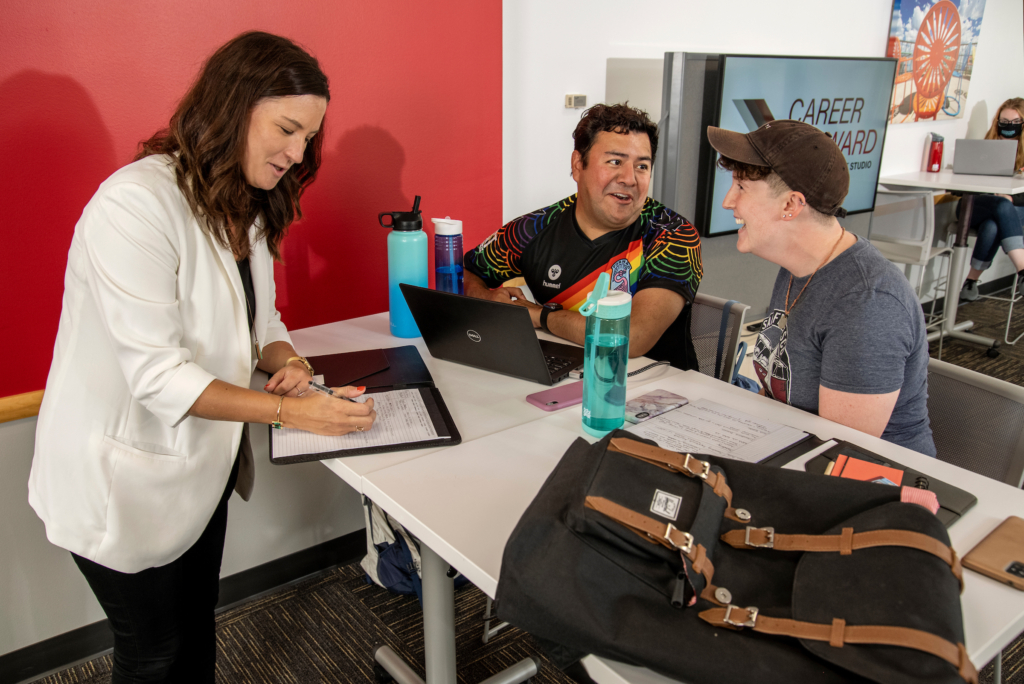
Badger undergrads get access to triple coaching which includes Success Coaches, Career Coaches, and Pathway Consultants. Photo by Paul L. Newby II / UW-Madison Wisconsin School of Business
Tell us about the new BBA curriculum you will launch next fall.
When I came here, we only had majors. Parents would very proudly come up to me and say, “My child is triple majoring in finance, marketing and supply chain.” I would say to myself, “Well, that’s great, but how exactly did that help them get a job?”
We found that we needed to build a more modular curriculum. So, in the BBA, you will have a major aligned around your career pathway, but you will embellish that with certificates and what we call badges, which are six-credit offerings which you can also take from other schools on campus.
Somebody who wants to build a career pathway around investment banking, what we want them to do is major in finance, get a badge in ESG, get a badge in data analytics, and so on. So the first principle is we are modularizing our curriculum and marrying the curriculum with the career pathways in what I call a chauffeured journey from freshman to senior.
The second thing is we’re filling the gap by adding four new courses. The first we’re calling sustainable capitalism. It’s a sophomore course where students learn that people, planet, profit, and society mutually coexist. Modern business managers must develop a lens for integrative thinking around that.
We already have a two-course sequence on technology and analytics, and we’re adding a third course on Cloud Analytics. And, while we are very strong in entrepreneurship, we wanted to marry that with design thinking. In my opinion it will be unique because while engineering schools have embraced design thinking, business schools are still not quite there. So we are adding a course on that. Part of the project will be identifying a stakeholder, mapping the journey, identifying the pain points, and thinking about how you will redesign the process. I think that’s a very important skill.
The fourth course is a capstone course on strategic leadership. That’s going to be a bold ambition. It’s going to be built on experiential learning, so imagine 1,000 students going through that, and working on a semester-long, practical problem. We’re trying to figure out how to do that for 1,000 students, and what we might do is build a portfolio of experiences and students choose one. They could work on a business startup, or guiding a nonprofit, or sustainability, or on a global project. It comes back to flexibility, choice and variety.
A principle in all of these is that when you’re a freshman, you’re learning the fundamentals of business. As a junior, you’re practicing around your career pathway, both through your electives, your badges and your clubs. And as a senior, in this capstone course, you’re demonstrating your mastery of being an integrator, innovator and inclusive leader.
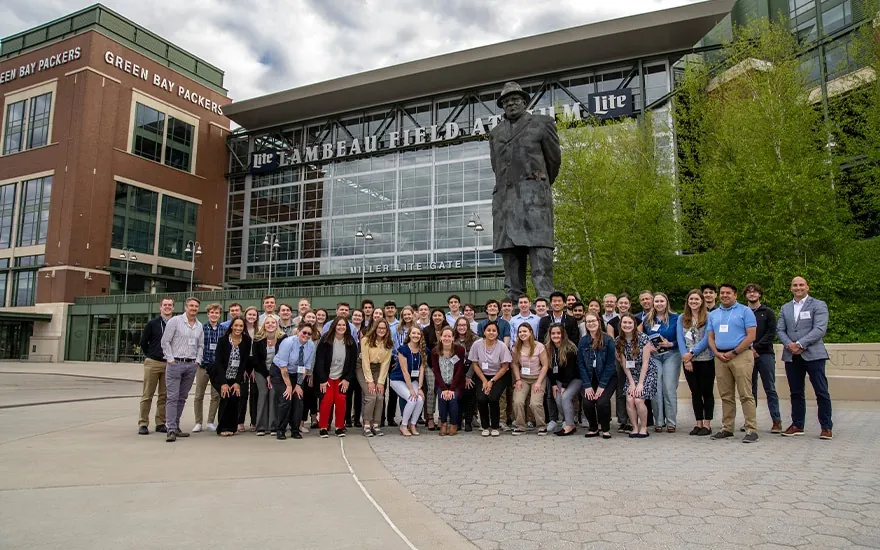
University of Wisconsin-Madison undergraduates pose outside Lambeau Field during their Leadership at Lambeau badge. Courtesy photo
In terms of badges, I’ve heard talk about that more in the graduate space. Is this something kind of new for the undergrad?
Yes. If you think about the evolution of BBAs in the last 10 years, Indiana was the first one that said beyond functional, students need the new integrated mindset. So they built the I-Core. The next layer was experiential learning, which you used to do in MBA programs. So now, if you look at any good program — Indiana, Ross, Gies, us — we all do that.
But the next thing is the principle of modularity and tailoring learning to your career path. Beyond a stable foundation of major, what you need is micro learning. A certificate is 12 credits, and there’s only so much real estate you have in your degree. But if you go down to badges, there’s more opportunity. We’ve already successfully experimented with badges in our graduate programs.
Now, here’s another twist on it. A badge could also be a co curricular experience. We have introduced a wildly popular badge called Leadership at Lambeau. We’re going to take students in a few weeks to spend three or four days to be consultants talking about leadership, interacting with the Green Bay Packer organization, and doing experiential learning. It’s a non credit badge in the undergraduate space.
So, we are experimenting with both credit and non credit badges. We also already have a highly successful Accenture leadership badge, and that’s so popular that students all across campus come into that. And when they show that on their resume, it gets them talking. This is already a proven model, it works well in the graduate program, let’s bring that down to the undergraduate space.
So, in your goal to be a top undergraduate program, and for the undergraduate program to be a crown jewel of the business school, what does that look like? What are the measurements?
Well, to be a top school, the employment placement rate has to be 98%. When I got here, we were at 89%. With our career forward and all these initiatives, we are making our way.

Inside the Wisconsin School of Business. Courtesy photo
In May we hit 95%, so we think our strategy is working. But that by itself is not enough. You are in the league of excellent schools because you do that, where you place them, salaries and all of that.
Where we will differentiate is in that student success model, the triple coaching. Our average time to graduation is 3.72 years, less than four. So that’s one.
Secondly, it is this modular curriculum which prepares students for 44 career pathways. The other thing that we think will happen is when they take badges, the most fundamental thing they will walk out with is not just knowledge, but learning to learn. And, they’ll want to continue to learn. Soon we will put these badges fully online so that any of our alumni can consume them for their own upskilling and rescaling. I think those are the places where we think we will be differentiated as unique.
Anything else you’d like to add?
When you’re working with a volume of almost 4,000 students, the types of change and movements that you have to make are much more significant. Ensuring that success for everyone, knowing that we have an increasingly diverse student body, is important.
To give you an idea, today we get 11,000 applications for 650 spots in our incoming class.
Secondly, we have become a national school. Today, California sends us 7% of our students. Illinois, Wisconsin, California, and New York are the top four states.
As a result, the culture of the place has changed, and our footprint is enabling us to say “coast to coast.” When I first went to Seattle last summer, they said, “Dean, great story, but why would a Madison kid come to Seattle?” I told them that actually, these are your Seattle kids who are coming to Madison, and they want to come home.
DON’T MISS: HOW DOES THIS BUSINESS MAJOR & CEO BALANCE SCHOOL WHILE RUNNING A GROWING COMPANY? and FRUSTRATED WITH WORK, PEOPLE ARE ‘RAGE-APPLYING’











Questions about this article? Email us or leave a comment below.